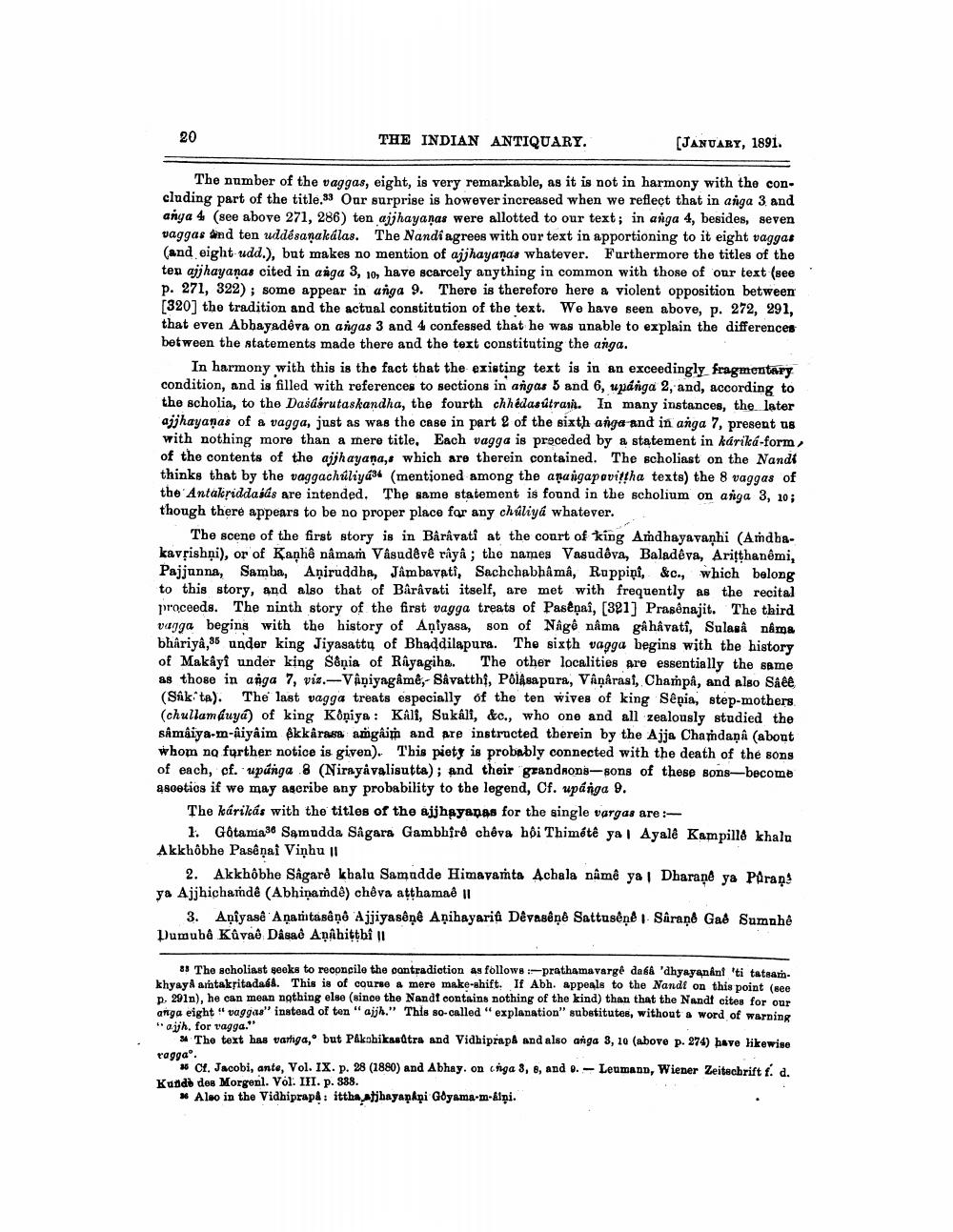________________
20
THE INDIAN ANTIQUARY.
(JANUARY, 1891.
The number of the vaggas, eight, is very remarkable, as it is not in harmony with the concluding part of the title 33 Our surprise is however increased when we reflect that in anga 3 and anya 4 (see above 271, 286) ten ajjhayaņas were allotted to our text; in anga 4, besides, seven vaggas and ten uddésanakalas. The Nandí agrees with our text in apportioning to it eight vaggas (and eight-udd.), but makes no mention of ajjhayanas whatever. Furthermore the titles of the ten ajjhayaņas cited in anga 3, 10, have scarcely anything in common with those of our text (see p. 271, 322); some appear in anga 9. There is therefore here a violent opposition between [320] the tradition and the actual constitution of the text. We have seen above, p. 272, 291, that even Abbayadeva on angas 3 and 4 confessed that he was unable to explain the differences between the statements made there and the text constituting the anga.
In harmony with this is the fact that the existing text is in an exceedingly fragmentary condition, and is filled with references to sections in angas 5 and 6, upanga 2, and, according to the scholia, to the Dasdárutaskandha, the fourth chhedasútrani. In many instances, the later ajjhayanas of a vagga, just as was the case in part 2 of the sixth anga and in anga 7, present us with nothing more than a mere title. Each vagga is preceded by a statement in káriká-form of the contents of the ajjhayaņas which are therein contained. The scholiast on the Nandi thinks that by the vaggachúliy434 (mentioned among the anangapavitha texts) the 8 vaggas of the Antaksiddasás are intended. The same statement is found in the scholium on arga 3, 20; though there appears to be no proper place for any chúliya whatever.
The scene of the first story is in Bârâvati at the court of king Andhayavanhi (Andhakavşishại), or of Kanhồ naman Vasudêvê râyâ; the names Vasudova, Baladeva, Aritthanômi, Pajjunna, Samba, Aniruddha, Jámbavati, Sachchabhâ mâ, Ruppiņi, &c., which belong to this story, and also that of Bârâvati itself, are met with frequently as the recital proceeds. The ninth story of the first vagga treats of Pasēņai, [321] Prasenajit. The third vagga begins with the history of Aniyasa, son of Nagê náma gâ hâvati, Sulaså nema bhâriyâ,35 under king Jiyasatty of Bhaddilapura. The sixth vagga begins with the history of Makâyi under king S&ņia of Rayagiha. The other localities are essentially the same as those in anga 7, viz.-Vâniyagâmê,- Såvatthi, Põlasapura, Vâņkrasi, Champå, and also Sale (Sikita). The last vagga treats especially of the ten wives of king Sênia, step-mothers. (chullamáuya) of king Köniya : Kali, Sukáli, &c., who one and all zealously studied the sâmâiya-m-aiyâim ekkârass amgâim and are instructed therein by the Ajja Chamdaņa (about whom no further notice is given). This piety is probably connected with the death of the song of each, cf. upanga 8 (Nirayávalisutta); and their grandrong-sons of these sons-become asootios if we may ascribe any probability to the legend, Of. upanga 9.
The kárikás with the titles of the ajjhạyanas for the single vargas are:
1. Gøtama36 Samudda Sagara Gambhîrê chêva hội Thimótê ya 1 Ayale Kampilld khala Akkhôbhe Pasêņai Viņhu 11
2. Akkhôbhe Sagaré kbalu Samudde Himayamta Achala nûmê ya Dharanê ya Para ya Ajjhicharde (Abhinande) chêva atthamae il
3. Aņiyasê Añatitasênê Ajjiyasênê Aņihayarihi Devasêne Sattusêņê Sîranê Gað Sumuhê Dumubê kû vaê Dasaé Apahittbill
# The scholiast seeks to reconcile the contradiction as follows:--prathamavargé dala 'dhyayanánt 'ti tatsat khyaya aitaksitada6d. This is of course a mere make-shift. If Abh. appeals to the Nandi on this point (see p. 291n), he can mean nothing else (since the Nandt contains nothing of the kind) than that the Nandt cites for our anga eight "vaggas" instead of ten "ajjh." This so-called "explanation" substitutes, without a word of warning "ajjh, for vagga."
The text has varga," but Pakshikastra and Vidhiprape and also anga 3, 10 (above p. 274) have likewise
ragga
* Cr, Jacobi, ante, Vol. IX. p. 28 (1880) and Abhay. on nga 3, 8, and o. -Leumann, Wiener Zeitechrift f. d. Kundo dos Morgenl. Vol. III. p. 388.
* Also in the Vidhiprapa: ittha atjhayapkpi Gdyama-m-liņi.




